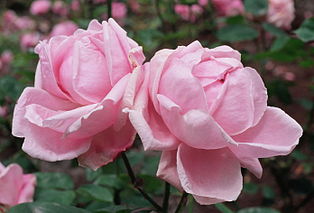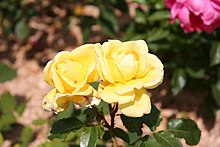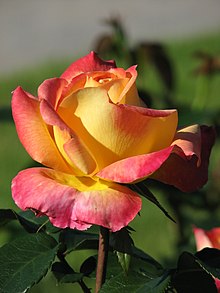Hybrid tea
| Rosa 'Madame Caroline Testout' | |
|---|---|

|
|
| group | Hybrid tea |
| origin | France |
| breeder | Pernet-Ducher |
| Breeding year | 1890 |
| List of rose varieties | |
The hybrid tea or hybrid tea rose form the oldest class of "modern" cultivated roses . They were first crossed from Chinese tea roses and European remontant roses in the 19th century . The genes of the China roses have fundamentally changed the properties of the newly introduced rose classes. In addition to positive properties such as permanent bloom, the expansion of the color range and new fragrances, negative factors - such as susceptibility to rose diseases, a low or absent fragrance of some varieties, and often low winter hardiness - found their way into the breeding lines of modern roses.
The first hybrid tea

The definition of the American Rose Society ARS from 1966 states that a rose can be described as an "old rose" if it belongs to a rose class that existed before the introduction of the hybrid tea. It is generally said that the rose variety ' La France ' (Guillot 1867) is the first hybrid tea. It combines the desired permanent bloom with a pleasing growth, good frost resistance and the noble looking, tall buds that open into large flowers.
In the 19th century, when the current classification was developed, each new variety was classified by its mother variety; if it deviated too much from this, the word " hybrid " was added to the class name. For example, a “hybrid tea” was a rose made from the seed of a tea rose, fertilized by the pollen of the rose “of any” other class. This variety was not taken into account here because, on the one hand, it could often not be identified and, on the other hand, the prevailing view was that the pollinating variety only played a subordinate role in the formation of a hybrid. Targeted crosses with success were not made before 1860.
However, Henry Bennett began around 1870 to transfer the scientific knowledge of heredity from cattle breeding to rose breeding and to systematically breed tea rose hybrids with equal consideration of father and mother varieties. The Société Lyonnaise d´Horticulture called Bennet's roses around 1880 “tea hybrids”.
In 1809 Sir Abraham Hume introduced the rose 'Hume's Blush Tea-scented China'. Although this was apparently self-sterile, one day there was a seedling, presumably fertilized by a gallicarose . This rose was marketed in England in 1815 as 'Brown's Superb Blush'. From today's perspective, the variety is a tea hybrid. However, it only bloomed once and was probably triploid and sterile.
Early varieties
- In 1867 the variety 'La France' (Guillot Fils) came. The indication, 'Mme Victor Verdier' × 'Mme. Bravy 'are their parents, is not proven. It is said, however, that Guillot himself said that he found this plant in a bed with a mixture of tea rose seeds. So he couldn't know anything about her parents. Guillot was also not a systematic rose breeder, because in the next 12 years he only brought out two more varieties, both also random seedlings.
- Then came 'Capitain Christy' (Lacharme 1873 - was called the hybrid tea), 'Cheshunt Hybrid' (George Paul 1872), 'Lady Mary Fitzwilliam' (Bennett 1883 - from 'Devioniensis' ×' Victor Verdier '),' Souvenir of Wootton '(John Cook 1888, dark red - is the first American tea hybrid from' Bon Silène '×' Louis van Houtte ') and then in 1890' Mme. Caroline Testout '(Pernet-Ducher - from' Mme. De Tartas' × 'Lady Mary Fitzwilliam').
Only since then has the class designation "hybrid tea" been used in today's sense. Now the time of rose breeding, especially the hybrid tea, had dawned and this group had become the largest of all times. Some of the early tea hybrids were strong in growth and also well hardy, but many were sensitive due to their descent from the frost-sensitive tea rose. Through the continued crossing, inbreeding and following certain breeding directions, the tea hybrids degenerated considerably over time.
Further development


That got even worse when the "Pernetiana roses" were created by crossing with Rosa foetida . Although these broadened the color spectrum very pleasantly, they considerably reduced the plants' resistance to diseases (especially black spots and rust) and the vigor.
The “Pernetiana” or “Pernetrosen” are now completely fused with the tea hybrids, but at the beginning of their development they formed a separate group. The hybrid tea flowers (apart from the offspring of 'Parks Yellow Tea-scented China') generally only bloomed pink, red or white, with all the nuances in between, while a real yellow was missing. A golden yellow, rather large-flowered wild rose , Rosa foetida (syn. Rosa lutea ), was brought by Clusius from Asia Minor to Europe in 1542, namely to Austria. It was spread from here. In 1596 Gerard knew this rose ('Austrian Yellow') in England and also its mutation 'Rosa foetida Bicolor' (= 'Austrian Copper'). The latter is a rose with a wonderful color combination, golden yellow outside and copper red inside. It was significantly more beautiful than the native light yellow dune rose ( Rosa pimpinellifolia ). Both have a flaw, however, because the flowers do not have a pleasant scent; they actually smell a bit like bed bugs. The leaves were also very susceptible to sooty, and ultimately, and crucially, the flowers were sterile.
In 1837 Sir John Willock found a rather large-flowered form of the Rosa foetida in Persia , which was named 'Persian Yellow'. She had the same bad traits as the mother variety, but was fertile. Finally, in 1900 Pernet-Ducher made a first start. He crossed the purple-red Remontant rose 'Antonie Ducher' with 'Persian Yellow'. Most of the seedlings from here were worthless, so he threw away all but one, who was particularly vigorous. When one day he found a fragrant, beautiful yellow flower here, he was surprised to see that it belonged to a weak seedling that happened to be standing by; this weak seedling, which he called 'Soleil d'Or', became extremely important for the breeding of the Pernetiana roses. Pernet-Ducher continued to cross with his yellow roses and achieved 'Souvenir de Claudius Pernet' and others in 1920. But now the other breeders began to cross with the yellow roses, and the colors of our modern roses emerged. Nevertheless, it should not be overlooked that by 1940 the hybrid tea had passed the peak of their perfection and showed signs of degeneration.
In 1945 ' Gloria Dei ' von Meilland brought about the big turning point. The extremely strong-growing rose was not only very healthy, but also had large, noble flowers, in general all the properties that one could wish for. A new period of breeding activity began and it continues.
Only a few may be called the World Rose .
Modern tea hybrids
A selection of modern tea hybrids:
| variety | breeder | year | colour | Award | photo |
|---|---|---|---|---|---|
| 'Aachen Cathedral' | Meilland | 1981 | pink | ||
| 'Ambience' | Noack | 2001 | White | ||
| 'Augusta Luise' | Rosen Tantau | 1999 | pink | ||
| 'Baccarat' | Meilland | 1954 | red | ||
| 'Camp David' | Rosen Tantau | 1984 | red | ||
| 'Double Delight' | Swim & Ellis | 1978 | Red White | World Rose 1985 | |
| ' Scent Cloud ' | Rosen Tantau | 1963 | coral red | World Rose 1981 | |
| 'Florence on the Elbe' | Le Cannet-des-Maures | 1997 | pink | ||
| 'Elina' | Dickson | 1984 | creamy white | World Rose 2006 | |
| 'Freedom' | Dickson | 1984 | yellow | ||
| 'Garden Party' | Swim | 1959 | White | ||
| 'Gloria Dei' | Meilland | 1945 | yellow-pink | World Rose 1978 | |
| 'Ingrid Bergman' | Poulsen | 1984 | red | World Rose 2000 | |
| 'Cologne Carnival' | Cord | 1964 | lilac to lavender | ||
| ' Queen of the Roses ' | Cord | 1964 | salmon orange | ||
| ' Papa Meilland ' | Meilland | 1963 | red | World Rose 1988 | |
| ' Pascali ' | Lens | 1963 | White | World Rose 1991 | |
| 'Queen Elizabeth' | Lammerts | 1954 | pink | World Rose 1978 | |
| 'Sebastian Kneipp' | Cord | 1997 | White | ||
| 'Sonia Meilland' | Meilland | 1971 | salmon pink | ||
| 'Super Star' | Rosen Tantau | 1960 | vermilion | ||
| 'Wimi' | Rosen Tantau | 1982 | pink | named after Willy Millowitsch |
literature
- Gerd Krüssmann: Rosen, Rosen, Rosen - Our knowledge about the rose , Verlag Paul Parey: Berlin and Hamburg 1974, ISBN 3-489-71722-8
Web links
Individual evidence
- ^ Heide Rau, Duftrosen , page 58, ISBN 3-8338-0529-3
- ↑ Ute Bauer, Alte Rosen , page 25, ISBN 3-405-16713-2
- ^ Charles & Brigid Quest-Ritson: Roses: the great encyclopedia / The Royal Horticultural Society; Translation by Susanne Bonn; Editor: Agnes Pahler; Starnberg: Dorling Kindersley, 2004, page 57, ISBN 3-8310-0590-7



























